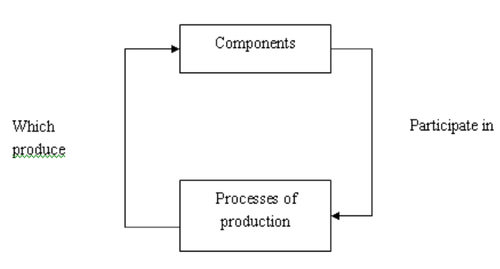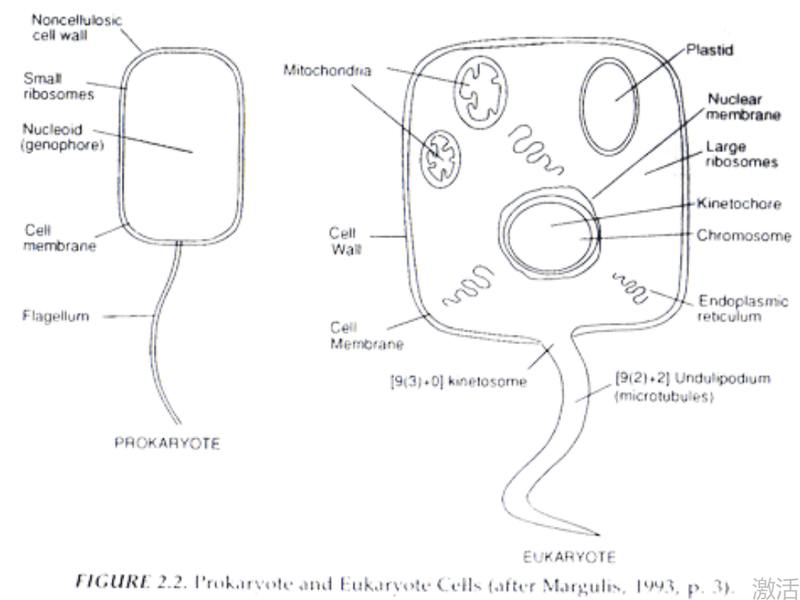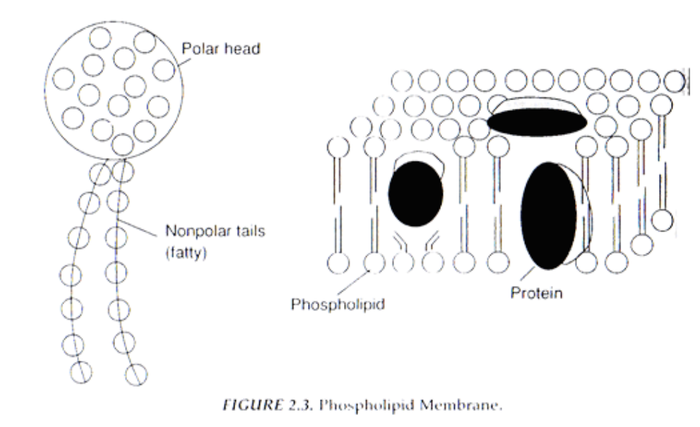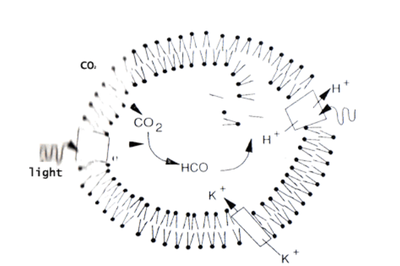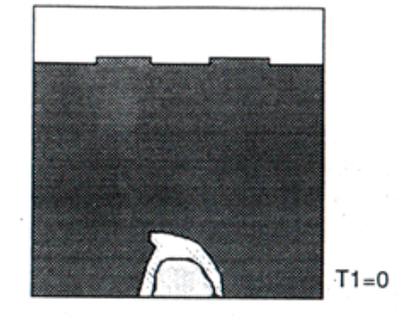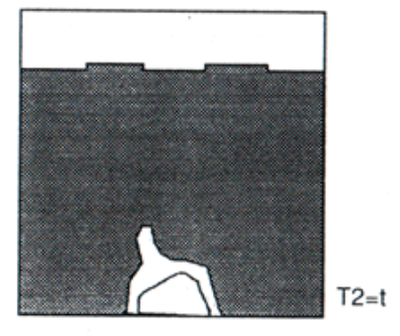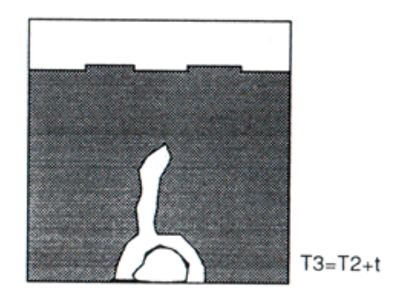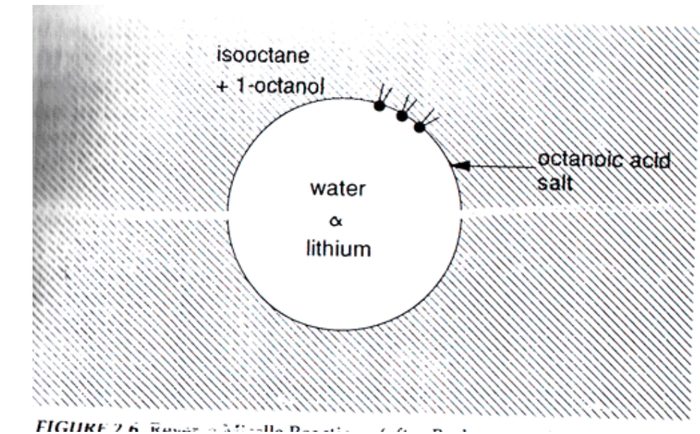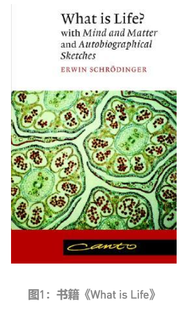生命系统的组织
生命系统的组织
The Organization of living systems
- John Minger:《Selfproducing systems-- Implications and Applications of Autopoiesis》一书第二章
- 张江翻译:
注:近年来,Autopoiesis在西方有关复杂系统、人工生命等领域的文献中频繁出现。该理论虽然不算新,但是对生命的认识可谓独到。它把生命看作一个自我创生的系统,即自己生产自己的一个自指系统,思想简洁而深刻。John Minger的Self-producing systems一书虽然不是Autopoiesis理论的开山之作,但是叙述清晰、逻辑性很强,因此本人把该书的第二章描述Autopoiesis理论这部分摘出来反映,希望能够引起更多学者的注意。
2.1 自创生理论的基本思想
Maturana和Varela(自创生理论Autopoiesis的两位创始人,智利的生物学家)提出的主要问题是:究竟什么是我们区分生命系统和非生命系统的本质原因?要知道,非生命系统也可能与生命系统同等复杂,那么我们究竟为什么可以判断它不是活的?正如Martian所问:什么是我们区别马和汽车的本质原因?这也就是Monod曾经用来说明自然系统和人造系统的本质区别的著名问题。
对于生物学家来说,这个问题由来已久,而且回答各式各样。首先,活力说认为在生命中,有某种未观察到的物质或者力量、规律可以说明生命的各种奇特的现象。其次,系统科学的发展以及一系列概念的提出包括反馈、动态平衡、开放系统等等为生命体那复杂的、具有很强目的性行为提供了机械论式的解释。虽然这种方法是一个大的进步,但是它无法解释为什么类似的机制和特征也可以被非生命的简单机器进行很好的构建。
第三种方法,也就是近来最普遍的方法,就是给生命组织提供一个基本的特征列表,——例如自我繁殖能力、信息处理能力、碳基化学基础以及核酸结构等等。这种方法的第一个困难是它完全是一种描述而并不是真正意义上的解释。它的确很有效,尤其当我们对没有争议的生命系统进行观察并关注它们的共性特征的时候。然而,这种技巧恰恰用“生命与非生命的区别”为理由对其自身进行了解释,也就是它仅仅是一种同意反复。因为这种方法并没有定义生命系统所独有的特征,也没有对这种特征如何生成我们所观察到的现象作任何解释。第二,人们不可避免地会对列表的内容缺乏共识。任意两个列表可能包含了不同的特征,并且我们很难验证列表中的每一种特征都是实际必须的,而且也很难验证列表是真正完全的。
Maturana和Varela的工作是基于对生命系统的自然现象的一系列观察之上作出的,我们将在这里进行简单的介绍,更详细的讨论放在后续的章节。
Maturana和Varela稍微不同于现代流行的趋势:把眼光集中到物种或者基因上,他们更加关注单一的生命个体(例如,一个像阿米巴变形虫那样的单独细胞)作为中心实例。这类生命实体的一个基本特征是个体的主动性。虽然它们可能是有机生命、种群或者物种的一部分,并且常常被环境影响,然而个体是一种受限制的、自我定义的实体。
生命系统使用一种机械的方法来操作、行动。它们包含了拥有各种属性和相互作用的独特部件。而系统整体的行为完全是由这些部件和它们的属性通过与相邻元素的相互作用而生成的。因此,任何对于生命系统的解释必须纯粹的依赖于机械的方法。
所有的解释或者描述都来源于系统之外的观察者(即人)。人们必须弄清楚什么是属于观察者的而什么是属于被观察对象的。观察者可以感觉到实体和实体的环境,以及两者是如何相关的。然而,实体中的部件却并不能区分开来,它们只是纯粹的对其他部件进行反应。
上述的最后两点导致了这样一个思想:任何对生命系统的解释都应该是非目的论的,即该解释不能向功能和目的的思想求援。生命系统的任何可观察现象都应该来源于纯粹的相邻内部组件之间的相互作用。而对于那些能够表现出某种与整体相关功能的观察仅能够被外界观察者,也就是能够描述部件、整体以及二者之间关系的人做出。
为了揭示生命系统的自然属性,Maturana和Varela两个人把目光集中到了一个基本的实例上:活体细胞。简要地说,一个细胞是由细胞膜包围而成的各种结构组成,包括核酸、线粒体、溶酶体当然还有它内部产生的各种各样的(通常也是复杂的)分子。这些结构发生着持续的化学相互作用。而对于细胞膜来说,这种相互作用就是它与外部介质的关系。所以细胞实际上是一种动态的、包含着惊人复杂性的化学网络。
那么究竟什么是类似细胞这样的主动、动态、鲜活的系统的整体特征呢?什么区别了一般的机器和生命呢?例如一个化学工厂也包含了大量复杂的部件,并且也通过相互作用的生产来形成一个组织整体,它们与生命的区别是什么呢?我们不能解释说:因为细胞正在执行一个更大的多细胞体生物的某种特定功能或者目的,所以该细胞才是活的。其原因是单细胞生命也可以通过自己的方式谋生而无论是否为更大的多细胞生命体的一部分。我们也不能用还原论的方法来通过某一个特定的细胞结构或者部件例如核酸或者DNA/RNA来解释。也就是说生命的活性必然产生于各种部分组织到一起的方式而不是某一个部件。为了理解Maturana和Varela的回答,我们首先要考察两个相关的问题:细胞在做什么,也就是细胞在生产什么?和什么生产了细胞?在这里,生产的意思是针对一个细胞自己而言的,而不是细胞的繁殖结果。
细胞在做什么呢?我们将在2.3节对这个问题进行详细讨论。然而,从原则上讲,它无非是在产生很多细胞体内的复杂的或者简单的物质(或者成为细胞膜),这些物质还能进一步参加新的生产细胞内部组成物质的过程。当然还有一些分子作为废料通过细胞膜从细胞中排泄了出去。那么,什么产生了细胞中的各种部件呢?现在可以回答,通过外部媒介输入的基本化学材料的帮助,细胞生产了它自己的构成。也就是说,一个细胞生产了它自身的部件,即这些部件的生产过程成为了一个闭圈(Closure)、一个正在进行的自我生产的过程(如图)。
对,细胞由自己生产,并在不停的生产着自己,除了它自己再没有其他东西了。这种简单的思想正是自创生理论的全部精华!!autopoiesis(自创生)这个词意味着自我生产,细胞中正在发生的就是不停地生产它自己。生命系统是自创生的(autopoietic)——它们将那些能够产生必要部件,并能够持续发展的过程组织了起来。那些并不能自我产生的系统被称为它生产的(allopoietic),例如,一条河流或者一块钻石。Maturana和Varela也把人造的系统称为异质生产的(heteropoietic),如化学工厂。粗略地说,化学工厂的确很像细胞,但是它产生的化学试剂被运到其他地方使用。这就不是“自我产生”了,同时产生和维护化学工厂的是人而不是化学工厂系统自身,所以说它不是自我生产的。
虽然乍看起来,这种想法非常普通,然而进一步深思就能发现它的重要性,例如:
- 1、想象我们要建造一个自创生的机器,除了基本的能量和化学物质以外,系统中的所有东西都要被这个机器自己生成。所以,该机器必然能够生产它的各种部件。显然,这台机器也是被其他的机器生产、维持和修复的,这同时意味着我们需要更多的机器生产“生产的机器”……。所有的生产部件的机器、生产机器的机器以及生产机器的机器的机器等等全部必须都来源于同一个实体。也就是说,我们要构建的自创生机器必须包含了这一连串的所有东西。
- 2、假设你成功了,那么可以肯定的是你所制作的机器将是一个自主的、独立的实体。这台机器将会有能力不断的自我构建和重建自己,用一种非常现实的想法来说就是这台机器不再被他的制造者而控制。那么它是活的么?
- 3、就像地球上的生命起源于化学物质的海洋一样,细胞在一群相互作用的化学物质中创造、重造着它自己的组成元素,并生成了一个稳定的、自我定义的实体来扩大自身在未来发展的机会。这是目前自创生理论研究工作的真正的基础。
- 4、那么什么是死亡呢?如果由于某种原因,无论是内部的还是外部的,只要自我生产过程中的某部分环节被破坏掉了,那么就没有东西能够产生必要的部件并且整个过程也就分散了。自创生理论就是这样,既可以说它概括了所有的事情,也可以说它什么也没说,整个过程都必须一致工作,否则系统就会分解掉。
那么,自创生理论最核心的思想是:生命就是那些所有的部件和过程都联合起来生产那些可以自我生产的实体,并把他们正确组织起来的一个系统。曾经其他的几个生物学家几乎也抓住了这个概念,正如本章开始提到的Rose。但是,Maturana和Varela两个人是第一个给这种生命生成机制命名、制定了一个标准并且探索了它的各种可能结果的人。
下面考虑Autopoiesis这个词语本身的来历,Maturana最开始没有用Autopoiesis这个词来解释生命这种现象,而是用类似环形的、自指的组织。事实上,该领域的第一篇文章:生物的认知并没有使用这个特定的词语。Maturana只是为了区分实现(行动的路径)和生产(创造的路径)而提出的。然而很有趣的是,德国现象学哲学家Martin已经预示了与Maturana相近的关于自己和他创生相似之处。在第一章的引言中,Martin使用术语创生来区分自我生产和被人类进行的他生产。Heidegger与Maturana工作的相关性还会在第7.5.2节讨论。
2.2 Autopoiesis理论的正式描述
目前,我已经对整个思想有了一个大致的描述,这一节开始更加详细的描述Maturana和Varela的理论细节。
我们观察到:所有的描述和解释都是来源于观察者,他(她)把一个实体或者一种现象从背景中区分出来。这种描述往往部分依赖于观察者的选择和观察过程,而且或多或少都会对被观察对象的实际行为造成影响。
Maturana把一个能被观察者从背景中区分出来的整体称为一个实体。例如,当我们称某物为汽车的时候,一些属性或者预定义的特征就被指定上去了(如它是可以移动的,可以载人,可驾驶的等等)。观察者还可以进一步把一个实体分解成多个单元和单元之间的关系,这种方法虽然不同但是仍然可以非常有效的来指定实体。它的结果就是把一个由多个部件构成的实体描述为一个整体的组织。
Maturana和Varela还特别强调区分实体的组织和实体的结构:
[组织]是指一种发生于部件之间的抽象关系。通过指定一个区域,组织在其中发生相互作用,并被赋予了不可分解的整体属性。组织这种关系定义了一个包含了某种特定类别组件的实体系统,并且决定了该实体的抽象属性。
[结构]是指实际的构成部件以及它们之间的实际关系。这些部件和关系必须满足于他们所属的合成实体的组织抽象关系,并且决定了一个发生部件之间的相互作用而扰动的空间区域,但是结构没有决定它作为一个实体应该具有哪些属性。(译者注:与我们的理解正相反,组织相当于抽象的类,而结构是指该类的一种特定实例)
组织包含了部件之间的关系以及为了刻画实体术语某种特定类别部件所必需具备的性质。这就决定了它的属性是作为一个整体的。我们可以用正方形的概念来说明组织。一个正方形用空间上部件之间的相互关系定义,正方形就是一个有四个相等边、并且用直角连接在一起的图形。这里正方形就是组织,而任何一个实现正方形的物理方式都是一种能够实现这种抽象组织的特定结构。另外一个例子就是飞机,它可以被定义为若干部件,如翅膀、引擎、控制器、刹车器、座椅而且这些部件之间的关系使得飞机可以飞起来。如果一个实体拥有这样的组织,那么他就会被定义为一个飞机,因为它可以产生我们对于飞机这个整体所期望的属性。另一方面,飞机的结构描述了任意一个包含实际的部件和实际的关系的实现,例如机场跑道上的波音757。
的确,这种使用术语“结构”的方法与通常有很大不同。一般的,在对系统的描述中,结构是与那些不发生缓慢变化的过程相对比的概念,结构和组织几乎是可以互换的。而这里,结构既指静态的也指动态的元素。结构和组织的差别仅仅是具体事例和所有实例背后的抽象普遍性相比较而言的。这使我们想起了经典的结构主义哲学,它们把表面上的经验事件“结构”与一个不可观察到的可以生成这种表面结构的深层结构(“组织”)相关起来。
因此,任何一个存在的合成实体都同时具有结构和组织。有很多种不同的结构可以实现同样的组织,并且每一种结构都会有很多属性和相互作用是不能被组织来指定的,也是与组织不相关的。例如,一个飞机的形状、颜色、尺寸和材质。进一步,结构可以在没有组织更改的条件下改变或被改变。例如,对于经历了很长时间的飞机来说,它有新组装的部件、涂了新漆,但它还是一个飞机因为它的底层组织没有变化。然而,有一些改变就会破坏组织的存在,例如,一次撞击事故把飞机变成了残骸。
结构和组织的本质区别就是整体与部分的区别。飞机只有在作为一个整体的时候才能够飞起来。这是它作为一个整体组成的属性,是它的组织。然而,它的部分,可以依赖于它的所有属性在它自身的领域中与其他部分进行相互作用,然而,它们仅仅作为一个个体的部件来这样完成。与一只小鸟相撞会使得引擎停止;一个线路短路可以毁掉整个控制。这些都是对于结构的干扰,也许这种扰动可以导致整个结构的破坏和消失,也可能是可以弥补的,以至于飞机仍然能正常飞行。
在这种背景下,我们可以很好的理解Maturana和Varela对Autopoiesis理论的定义了。一个实体是通过定义实体隶属于某个类别的组织来刻画的,并且组织决定了该实体所能产生的外在表现。Maturana和Varela把生命系统的本质看作是动态的和自主的,并且认为自我生产是产生这些特性的本质原因。因此,生命的组织就是一种自我产生的系统—Autopoeisis。这种组织当然可以被无穷多的结构来实现。
对自创生系统的一个更加明确的定义是:一个动态的系统,它是一个由部件生成的网络合成的实体,该实体满足:
- a) 通过相互作用迭代的再生产产生它们自己的网络
- b) 用一个空间上的实体来实现这个网络。该实体要能产生出与它所在的相互作用的背景分离的边界。
这段引文的第一部分详细叙述了自我生产系统的一般思想,第二部分则特别指定了系统必须被实际认出是一个整体,并且它的边界也是系统自己产生的。关于第二点产生边界很重要,尤其是当人们把自创生理论应用到其他非生命领域例如社会的时候。虽然对于细胞来说是该定义是非常清晰的,但是这个定义本身并没有限定系统的实现一定是物理的实体。这就使得该思想是开放的并且可以讨论一些非常抽象的自创生系统,例如一组概念,一个细胞自动机,或者是一个通讯的过程。对于这类抽象的系统来说什么是它们的边界呢?我们真的能把这类系统称为是“活的”么?事实上,这个主题是非常有争议的,详细请看第3.3.2节。
当我们考虑自然中的组织的时候,这个有些空乏的概念还可以得到进一步地扩展。特别是,组织将会涉及到部件之间的关系。根据Maturana和Varela的理论,在物理系统中,这种关系必然是三个种类之一:构造(Constitution),特化(Specification)和顺序(Order)。构造关系是一种系统上的物理学拓扑关系,也就是它的三维几何形体(比如一个细胞)。例如,他们都有细胞膜,各个部件都保持着特定的相对距离,它们都具有需要的尺寸和形状。特化关系决定了被各种构建过程生产的部件必须保持自创生的连续性。最后,顺序关系与过程的动态有关。例如,各种分子的适当配量是在正确的时间以正确的频率生产出来的。关于这些关系的具体细节将在后面论述,然而我们清楚的是,“何处”、“什么”、“何时”细胞中发生了各种复杂的生产过程已经被这三种关系粗糙的说明了。
对于这类“自创生”必需要关系的描述似乎有那么一些目的论的意味。事实上并不是这样的,Maturana和Varela非常强烈的反对这种解释。的确,如果这样的部件和关系发生了,那么它们就会使得电化学过程自己生产自己,并且在正确的频率下,生产正确的类型构造出一个自创生的系统。但事实上,这并不是必需的。因为这样简单的组合也许发生也许不发生,这就像植物生长也许依靠水、光和营养的正确组合,也许并不依靠一样。
为了使早期的这些抽象特征更具有可操作性,Varela在1974年的时候开发了一个自创生的细胞自动机模型,并提出了辨别自创生系统的六个关键点,它们是:
- i) 通过相互作用决定实体是否具有一个可区分的边界。如果可以区分出边界,则继续第2个步骤。如果没有,那么实体就是不可描述的,因此我们也没有什么可说的。
- ii) 如果实体有组成的元素,也就是实体的部件,这些部件是可以描述的,那么就进入第3步,否则实体是一个不可分析的整体因此也不是一个自创生的系统。
- iii) 判断实体是否为一个机械的系统,也就是系统的属性要能满足一定的关系,该关系决定了在实体中部件的交互和转换。如果这种情况满足,则跳到第4步,否则该实体不是一个自创生的系统。
- iv) 判断实体边界的组成元素和它们之间的关系是通过“近邻偏好相互作用”以及该实体所在的空间的属性来决定的。(译者注:这里的所谓近邻偏好相互作用preferential neighborhood interaction是指部件仅仅与它附近的局部元素发生相互作用而不是某种整体宏观的相互作用,就好比所有的人工生命模型一样,每个生命仅仅考虑它的局部环境而不失全局),如果不是这样,那么你没有得到一个自创生的实体,因为系统的边界不是由它自身决定的,而是由外界得到的。如果实体满足条件4,那么就跳到条件5
- v) 判断实体的边界是否由实体内的相互作用产生的,或者通过产生的部件转换构成了边界,或者是那些进入组织边界的元素通过耦合转化构成的。如果这些情况都不是,那么这就不是一个自创生实体。如果满足跳到下一步
- vi) 如果实体内的其他部件也是如第5步中的那样由部件之间的相互作用产生的,同时,虽然有些部件并不是由实体内部组件通过相互作用产生的,但是却参与了其他构成部件的必要而持久的生产过程,那么你就在部件存在的空间中得到了一个自创生的实体。如果不满足这些情况,也就是系统内的部件并不是像5那样由系统内部的其他部件生成的,那么你并没有得到一个自创生的实体。
前三个标准是非常普遍的,它强调用一个清晰的边界定义了一个可分辨的整体,并且这个实体可以被分解成若干部件,而且实体操作这些组件是一种机械的过程,也就是说这些过程都是由部件的属性和关系决定的。自创生思想的核心是最后的三条。这些标准描述了一个交互过程和生产过程的动态网络(vi),它产生了边界(v),并且这个边界被组件之间的“近邻偏好相互作用”所维护。关键的一个概念就是部件的生产,而且生产的这些部件构成了边界。尤其是当我们把自创生理论扩展到非物理系统的时候显得尤为重要。
我们将把这些评价标准应用到细胞身上。在这里我们将简要的描述自创生关系的实现,以及通过应用分子生物学中描述的细胞的构成,正如Alberts或Freifelder,Raven和Johnson等人介绍的。
2.3 细胞中的自创生过程说明
这一节将简单描述一个细胞中的化学物质自创生关系。Alberts等人曾经作过很好的有关分子生物学的介绍。
2.3.1 应用六个标准
Zeleny和Hufford曾经对一个典型的细胞从六个关键点进行了分析,两种细胞的示意图如下图所示,其中一个是真核细胞,也就是细胞内有细胞核的,另一个是原核细胞,其中没有细胞核。
- 1、细胞拥有可以确认的由离子形成的细胞膜边界,因此细胞是明确的实体。
- 2、细胞拥有明确的部件,例如线粒体、细胞核以及由众所周知的内置网形成的细胞膜网络。所以,细胞是可以被分析的。
- 3、所有的部件都拥有电化学属性,通用的物理规律决定了细胞内部部件之间的传输和相互作用。因此,细胞是一个机械的系统。
- 4、细胞的边界是由磷脂分子和特定的蛋白质合成的细胞膜构成。脂肪分子排列形成了双层结构,这种结构就可以形成选择性的渗透障碍,蛋白质在这种双层结构中也呈现膜状,调节形成了很多细胞膜的功能。一个脂肪分子有两个部分,一个具有极性的头是亲水的,和一个碳氢化合物的尾巴是厌水的。尾巴和头连接在一起形成了双层结构。完整的蛋白质也有吸水和厌水的区域,因此边界部分就通过近邻偏好关系而形成了自我修复的机制。
- 5、边界的脂肪和蛋白质部件是由细胞自己产生的。例如,大多数用于形成新的细胞膜的脂肪分子是由内置网形成的,而内置网是细胞的一个复杂的、膜状的部件。因此,边界部件是由系统自我产生的。
- 6、细胞中的所有其他部件(包括线粒体、细胞核、核糖酶素、内置网)都是被细胞以及在细胞内部产生的。一些化学成分(例如金属离子)不是被细胞产生的,而是通过细胞膜从外界输入进来的,但成为了细胞的操作部分,所以细胞的部件是自我生产的。
2.3.2 构造、特化和顺序的自创生关系
除了六个标准以外,自创生理论还定义了三种必要的关系类型,下面针对一个典型的细胞来说明这些关系。
2.3.2.1 构造关系
构造关系决定了细胞的三维形状和结构以便生产的其他关系可以被维护。这种关系是通过那些具备立体化学特性的分子并能够使得其他过程持续发生的分子来实现的。
一个明显的例子就是细胞膜或者细胞边界的构建。在动物细胞中,细胞膜是围绕着线粒体的,就像是围绕着细胞自己,它维护了细胞内的物质并且通过扩散而调节反应的速率。各种各样的反应分子沿着细胞膜按照一种特定的顺序分布着,以便能量生产能够有序而高效的完成。在植物细胞中,除了离子构成的细胞膜以外,还有一个包含了纤维素的细胞壁。这种纤维素是由葡萄糖物质长链包裹在一起而形成的钢硬的线,这就形成了植物的刚性。
第二个例子是蛋白质酶的活动位穴。这些活动位穴对于大部分反应来说起着催化剂的作用,它们能改变特定的物质而使得化学反应更容易发生。一般的,活动位穴存在于酶分子的特定位置。在这些位置上,氨基酸又是通过“催化剂”或者“合作酶”的帮助利用它结构的配置来适应特定的物质。物质分子和活动位穴相互锁定,只有当它们不再适应的时候才会改变。
2.3.2.2 特化关系
在化学特性上,这些关系决定了细胞组件的唯一性。这种关系促使细胞组件通过它们之间的相互作用参与了整个细胞的构建。在DNA和RNA以及组建产生的介于酶和酶催化的物质之间的蛋白质中有两种主要的结构对应。
蛋白质合成是很复杂的过程,因为每一种蛋白的形成都需要连接20种不同的氨基酸以形成特定的组合,总计大概需要300或更多的单元。这就需要RNA模板分子,就好像每个蛋白质的裁缝一样,它按照顺序包含了对每个氨基酸以及酶和t-RNA的特定空间。
正如已经论述的,酶对于细胞中的大多数反应都是必要的,另外,每一种特定的反应都需要特定的酶以及相应的物质。因此细胞需要上百种的酶,每一种都是由细胞自己生产的。
2.3.2.3 顺序关系
顺序关系涉及了细胞生产过程的动态。各种化学反应形成复杂的反馈闭环以保证各种产物的生产能够以正确的速率和顺序继续。例如,氧化反应的能量生产是在线粒体中被磷酸盐和ADP控制的。同时,化学反应消耗能量来生产ADP和磷酸盐,这样就可以使得整个过程自动化。并且,能量的高效利用就可以使得这些必要物质的生产更加高效。
2.3.3 其他可能的自创生系统
一个非常有趣的问题是,自创生系统是否有其他的实例呢?例如,多细胞生命是不是也是自创生系统呢?Maturana关于这个问题的判断是模棱两可的,他怀疑类似动物和植物这样的生物是二级自创生系统。也就是它们的组件不是细胞中的那些分子而是细胞本身。另外,他也建议一些细胞系统并不是真正的自创生系统,而仅仅是群落。那么关于那些存在着闭圈的组织关系系统,但人们并不认为是生命的系统是否为自创生的呢?最后,非物理系统例如自创生自动机以及一群思想或者一个社会是否为自创生系统呢?
2.4.自创生理论在生物和化学中的应用
读者一定认为正如自创生理论所声名的,它应该在生物学领域起到关键作用。而事实上,生物学界接受这个观点却用了很多年的时间。在1979年的时候,我曾经给英国的著名生物学家Steven Rose教授写信寻问自创生理论的情况。他回信说虽然Maturana是一个值得尊敬的生物学家,但是他不想对这个理论作出评价。生物学界有一个例外是Lynn Margulis,她提出了原核生命是由很多更简单的生命共生而形成的,这个理论本身也是备受争议的。
然而,随着生命的起源以及能够展现自创生特征的非生命化学系统这两个领域的增长,自创生理论在近年来受到了普遍的关注。人们还就自创生理论与Prigogine的耗散结构论进行了比较。Varela还曾经研究过免疫系统,免疫系统可以被认为是组织闭合的但却不是自创生的系统。由于这个问题比较专业,我们在这里就不讨论了。
2.4.1 最小的细胞以及生命的起源
关于地球上的生命起源研究有两个方法主线。第一种方法是基于酶和基因的,它认为生命是用分子的特征以及基因的功能和结构来刻画的。第二种方法是认为生命是用细胞的新陈代谢特征来刻画的。然而,这两种方法都没有提供一个标准的生命模型能够解决所有的重要问题。尤其是在什么样的条件下原生化学系统能够形成获得生命系统呢?我们如何认识非陆地生命系统呢?它们从结构上究竟与我们有什么区别?
Fleischaker提出自创生以及最小细胞的概念一起可以给第二种方法提供一个健全的理论框架。自创生理论的目标自然是给生命提供了一个有用的可操作的定义,虽然Fleischaker争论说自创生系统的定义需要做一定修改。这种修改就是要把“生命”系统局限在物理的自创生系统而不是非物理的可能的生命系统。关于这个问题我们将在第3.3.2节讨论。
当我们把自创生理论作为生命的定义的时候,下一个步骤就是考虑如何构造一个基本的自创生的系统。注意,自创生理论既提供了所有的东西也等于什么都没说。一个自我构建的系统要么存在产生了它自己要么根本就不存在。根本没有两种之间的情况。这就导致了给定了地球原始的条件是否能够涌现出理论上的最小细胞出来。实际上,Fleischaker考虑了三种不同的最小细胞的特征:最小的细胞应该能够代表我们熟悉的生命形式;最小细胞应该能够抓住地球生命同样也是非地球生命的特征。
关于最后一点,没有什么是超过应用于物理空间自创生系统的六点特征的,如果过于具体则会添加不必要的约束。另一方面,我们可以针对现代的细胞详细论述。这样的细胞可以看作是“拥有DNA环状结构、ATP驱动的、具备能量转换功能、由蛋白质细胞膜的包裹的以酶为介质的细胞质溶液集体”。这种概化的说明显然可以涵盖原核生物(如细菌)和真核生物(如海藻、真菌、动物、植物细胞)甚至它们可能存在显著不同。
最小的细胞途径包含了生命的起源。第一个细胞依赖于一个非常基本的没有后期类似酶机制的细胞。Fleischaker建议必须能够实现一些操作:
- 1、细胞必须能够展示出一个具有边界的结构的形成和维护。这种结构应该能够创造出一个良好的内部环境,并且还能够有选择的输入和输出分子和金属离子。现代细胞研究中发现的磷质双层结构促成了一个封闭球的形成并且避免了与水的接触。磷质双层结构在某方面说也是可渗透的并且可以在没有复杂酶相互作用的条件下进行,例如,它可以渗透钠原子以及质子。
- 2、细胞还必须拥有某种保持活动能量转换结构来维持自身避免化学的均衡。一个最早的形式就是被光驱动的光合系统。色素分子将会作为质子泵潜入到细胞膜中去并引起细胞内新材质的集中。
- 3、细胞必须使用、转换它自己的材料来构建它需要的组件及边界。这个过程的一个可能开始是二氧化碳的输入以及碳和氧在光的作用下的转换。
最重要的不是形成这些基本操作的特定机制,而是所有的这些操作都需要成为一个连续的动态的自我生产的网络整体。
2.4.2 化学自创生
除了理论上的最小细胞构建以外,如何根据自创生理论以及生命的标准来判断或者构建一个化学系统也是很有趣的。这里我们举三个例子:自催化过程,渗透性生长以及自复制胶体。
2.4.2.1. 自催化反应
催化剂是一种能够促进化学反应发生或者加速化学反应的分子物质,但并不被化学反应本身所改变。细胞的复杂构建(正如人们设想的生命起源的时候就存在的细胞)需要很多的催化剂,这恰恰是酶的一个重要功能。一个自创生的过程就是一个化学反应的副产品所创造的特定催化剂的生产过程。因此整个过程就是自催化的。一个实例是RNA分子的自构建过程,在特定的环境下,RNA可以形成像酶一样能够与其他RNA分子反应的复杂表面。考夫曼曾经专门在复杂性理论中探讨过这些问题。
虽然这个过程可以用一种自指的相互作用来表达,但是整个系统并不是自创生的,因为它并没有生产它自己的边界,因此也就不是一个能够构建自身的主动的整体。复杂的,相互依赖的化学反应过程虽然是普遍存在于自然界的,但是它们并不是自创生的除非他们能够形成自我约束的边界,从而实现自创生组织。
2.4.2.2 渗透性生长
Zeleny和Hufford建议曾经被Leduc研究的渗透性增长看作是自创生的。这种生长是由无机盐的扩展和沉淀形成的一个可渗透的边界。氯化钙与饱和的钠磷酸盐反应可以说明这个过程。钙和磷酸盐的交互形成了磷化钙沉淀的细边界层。这个层会将磷和钙分离,水会通过渗透穿过边界。提高的内部压力会打破沉淀的磷化钙。这种穿透会进一步促进内部的钙和外部的磷接触,因此形成进一步的沉淀。因此,这个沉淀层就会进一步增长。
Zeleny和Hufford声明这个系统满足自创生的六个标准:
- 1、首先,渗透边界形成了渗透性生长是一个可区分的实体;
- 2、其次,它可以被分解为更小的部件例如磷化钙边界以及氯化钙;
- 3、整个过程服从物理规则;
- 4、由于近邻偏好的关系,部件磷化钙聚集形成了边界;
- 5、边界是由内部和外部部件在膜的边界处相互作用而形成的;
- 6、组件(氯化钙)虽然不是被细胞产生但是其他部件(沉淀物)生产的永久组成物。
这种假设的确会引起一些问题,正如Leduc的系统明显是无机的并且不能被称为活的。如果我们接受该系统符合现在的自创生系统的标准,那么我们也就会不得不扩展我们对生命的理解。事实上,渗透性生长过程是否满足那六条标准是值得争议的。前三条是当然满足的,但是第四条并不满足,因为它并不是一个相互作用的网络在不断生产。
对于第四条,由沉淀形成的边界并不像细胞膜。它是一个静态的被动的边界,更像是石头墙而不是细胞膜。它并没有形成“近邻偏好的相互作用”;事实上,这种边界一旦形成,它就根本没有相互作用了。第五条:边界组件是由内部生产过程持续不断地生成这点也不满足,而是由边界的破裂以及破裂处的进一步沉淀形成的。最后,氯化物也不是系统自己生成的而是一开始就存在的一个单一部件。
2.4.2.3 自复制胶化物
另外一个现象是Bachmann及其同志们研究的。一个胶化物就是一个有机化学物的小液滴,如酒精滴在水中,并且被表面活性剂包围。反胶化物是水滴在有机溶剂中形成的。胶化物中会发生化学反应,不断产生更多的表面活性物。最后,这就会导致胶化物的分离并形成一个新的胶化物。整个过程是自复制的。普通胶化物和反胶化物以及在酶催化作用下的化学反应已经被实验证实。
在反胶化物实验中,水滴包含了溶解的氢氧化铝,表面活化剂是辛酸钠以及1-辛醇(也是一种溶液)。另外还有异辛烷溶液。主要的化学反应是边界组件不断的产生边界组件自己。当锂作催化剂的时候Octyl octanoate是可水解的。由于氢氧化铝在有机溶液中是不可溶解的,因此它会包在水的胶化物之中,大量的胶化物会生成,虽然它的尺寸会慢慢减小。 这些系统被称为是自创生的是值得怀疑的。首先,原始材料(水和铝的混合物或者酶催化剂)不是在系统内部产生的。这就限制了复制的发生次数,系统最终会停止下来。甚至如果这些材料可以被持续添加,系统仍然不是自生产的。第二,单层次表面活性剂不能被原始材料输送到胶体中。所以,一种如真实细胞膜的双层次边界就是必需的了。进一步,研究者们更加关注的是胶化物的自我复制,并认为这就是自创生的。然而,自复制是自创生的第二阶段。无论如何,这种现象说明这不是自创生的过程。
英文原文:
2.1 The essential idea of Autopoiesis
The fundamental question Maturana and Varela set out to answer is: what distinguishes entities or systems that we would call living from other systems, apparently equally complex, which we would not? How, for example, should a Martian distinguish between a horse and a car? This is an example that Monod (1974, p. 19) uses in addressing the similar but not identical question of distinguishing between natural and artificial systems.
This has always been a problem for biologists, who have developed a variety of answers. First came vitalism (Bergson, 1911; Driesch, 1908), which held that there is some substance or force or principle, as yet unobserved, which must account for the peculiar characteristics of life. Then system theory, with the development of concepts such as feedback, homeostasis, and open systems, paved the way for explanations of the complex, goal-seeking behavior of organisms in purely mechanistic term ( for example, Cannon, 1939; Priban, 1968). While this was a significant advance, such mechanisms could equally well be built into simple machines that would never qualify as living organisms.
A third approach, the most common recently, is to specify a list of necessary characteristics that any living organism must have – such as reproductive ability, information-processing capabilities, carbon-based chemistry, and nucleic acids (see, for example, Miller, 1978; Bunge, 1979). The first difficulty with this approach is that it is entirely descriptive and not in any real sense explanatory. It works by observing systems that are accepted as living and noting some of their common characteristics. However, this tactic assumes precisely that which is in need of explanation – the distinction between the living and the nonliving. The approach fails to define the characteristics particular to living systems alone or to give any explanation as to how such characteristics might generate the observed phenomena. Second, there is, inevitably, always a lack of agreement about the contents of such lists. Any two lists will contain different characteristics, and it is difficult to prove that every feature in a list is really necessary or that the list is actually complete.
Maturana’s and Varela’s work is based on a number of fundamental observations about the nature of living systems. They will be introduced briefly here but discussed in more detail in later chapters.
1. Somewhat in opposition to current trends that focus on the species or the genes (Dawkins,1978), Maturana and Varela pick out the single, biological individual (for instance, a single celled creature such as an amoeba) as the central example of a living system. One essential feature of such living entities is their individual autonomy. Although they are part of organisms, populations, and species and are affected by their environment, individuals are bounded, self-defined entities.
2. Living systems operate in an essentially mechanistic way. They consist of particular components that have various properties and interactions. The overall behavior of the whole is generated purely by these components and their properties through the interactions of neighboring elements. Thus any explanation of living systems must be a purely mechanistic one.
3. All explanations or descriptions are made by observers (i.e., people) who are external to the system. One must not confuse that which pertains to the observer with that which pertains to the observed. Observers can perceive both an entity and its environment and see how the two relate to each other. Components within an entity, however, cannot do this, but act purely in response to other components.
4. The last two lead to the idea that any explanation of living systems should be nonteleological, i.e., it should not have recourse to ideas of function and purpose. The observable phenomena of living systems result purely from the interactions of neighboring internal components. The observation that certain parts appear to have a function with regard to the whole can be made only by an observer who can interact with both the component and with the whole and describe the relation of the two.
To explain the nature of living systems, Maturana and Varela focus on a single basic example – the individual, living cell. Briefly, a cell consists of cell membrane or boundary enclosing various structures such as nucleus, mitochondria, and lysosomes as well as many (and often complex) molecules produced from within. These structures are in constant chemical interplay both with each other and, in the case of the membrane, with their external medium. It is a dynamic, integrated chemical network of incredible sophistication (see for example Alberts et al.,1989; Raven and Johnson,1991).
What is it that characterizes this as an autonomous, dynamic, living whole? What distinguishes it from machine such as a chemical factory which also consists of complex components and interacting processes of production forming an organized whole? It can not be to do with any functions or purposes that any single cell might fulfill in a larger multi-cellular organism since there are single-cellular organisms that survive by themselves. Nor can it explained in a reductionist way through particular structures or components of the cell such as the nucleus or DNA/RNA. The difference must stem from the way of the parts are organized as a whole. To understand Maturana and Varela’s answer, we need to look at two related questions – what is it that the cell does, that is what is it the cell produces? And what is it that produces the cell? By this I mean the cell itself rather than the results of their reproduction.
What does a cell do? This will be looked at in detail in Section 2.3 but, in essence, it produces many complex and simple substances which remain in the cell (become of the cell membrane) and participate in those very same production processes. Some molecules are excreted from the cell, through the membrane, as waste. What is it that produces the components of the cell? With the help of some basic chemicals imported from its medium, the cell produces its own constituents. So a cell produces its own components, which are therefore what produces it in a circular, ongoing process (Fig. 2.1)
It produces, and is produced by, nothing other than itself. This simple idea is all that is meant by autopoiesis. The word means “self-producing” and that is what the cell does: it continually produces itself. Living systems are autopoietic – they are organized in such a way that their processes produce the very components necessary for the continuance of these processes. Systems which do not produce themselves are called allopoietic, meaning “other-producing” – for example, a river or a crystal. Maturana and Varela also refer to human-created systems as heteropoietic. An exemple is a chemical factory. Superficially, this is similar to cell, but it produces chemicals that are used elsewhere, and is itself produced or maintained by other systems. It is not self-producing.
At first sight this may seem an almost trivial idea, yet further contemplation reviews how significance it is. For example:
1. Imagine try to build autopoietic machine. Save for energy and some basic chemicals, everything within it would itself have to be produced by the machine itself. So, there would have to be machines to produce the various components. Of course, these machines themselves would have to be produced, maintained, and repaired by yet more machines, and so on, all within the same single entity. The machine would soon encompass the whole economy.
2. Suppose that you succeed. Then surely what you have created would be autonomous and independent. It would have the ability to construct and reconstruct itself, and would, in a very real sense, be no longer controlled by us, its creators. Would it not seem appropriate to call it living?
3. As life on earth originated from a sea of chemicals, a cell in which a set of chemicals interacted such that the cell created and re-created its own constituents would generate a stable, self-defined entity with a vastly enhanced chance of future development. This indeed is the basis for current research, to be described in section 2.4.1
4. What of death? If, for some reason, either internal or external, any part of the self-production process breaks down, then there is nothing else to produce the necessary components and the whole process falls apart. Autopoiesis is all or nothing – all the processes must be working, or the systems disintegrates.
This, then, is the central idea of autopoiesis: a living system is one organized in such a way that all its components and processes jointly produce those self-producing entity. This concept has nearly been grasped by other biologists, as the quotation from Rose at the start of this chapter shows. But Maturana and Varela were the first to coin a word for this life-generating mechanism, to set out criteria for it (Varela et al., 1974), and to explore its consequences in a rigorous way.
Considering the derivation of the word itself, Maturana explains that he had the main idea of a circular, self-referring organization without the term autopoiesis. In fact, biology of cognition, the first major exposition of the idea, does not use it. Maturana coined the term in relation to the distinction between praxis (the path of arms, or action) and poiesis (the path of letters, or creation). However, it is interesting to see how closely Maturana’s usage of auto- and allopoiesis is actually foreshadowed by the German phenomenological philosopher Martin Heidegger. In the quotation at the start of Chapter 1, Heidegger uses the term poiesis as a bringing-forth and draws the contrast between the self-production (heautoi) of nature and the other-production (alloi) that humans do. Heidegger’s relevance to Maturana’s work will be considered further in Section 7.5.2
2.2 Formal Specification of Autopoiesis
Now that I have sketched the idea in general terms, this section will describe in more detail Maturana’s and Varela’s specification and vocabulary.
We begin from the observation that all descriptions and explanations are made by observers who distinguish an entity or phenomenon from the general background. Such descriptions always depend in part on the choices and processes of the observer and may or may not correspond to the actual domain of the observed entity. That which is distinguished by an observer, Maturana calls a unity, that is, a whole distinguished from a background. In making the distinction, the properties which specify the unity as a whole are established by the observer. For example, in calling something “a car,” certain basic attributes or defining features (it is mobile, carries people, is steerable) are specified. An observer may go further and analyze a unity into components and their relations. There are different, equally valid, ways in which this can be done. The result will be a description of a composite unity of components and the organization which combines its components together into a whole.
Maturana and Varela draw an important distinction between the organization of a unity and its structure:
[Organization]refers to the relations between components that define and specify a system as a composite unity of a particular class, and determine its properties as such a unity … by specifying a domain in which it can interact as an unanalyzable whole endowed with constitutive properties.
[Structure] refers to the actual components and the actual relations that these must satisfy in their participation in the constitution of a given composite unity [and] determines the space in which it exists as a composite unity that can be perturbed through the interactions of its components, but the structure does not determine its properties as a unity. Maturana (1978, p. 32)
The organization consists of the relations among components and the necessary properties of the components that characterize or define the unity in general as belonging to a particular type or class. This determines its properties as a whole. At its most simple, we can illustrate this distinction with the concept of a square. A square is defined in terms of the (spatial) relations between components – a figure with four equal sides, connected together at right angles. This is its organization. Any particular physically existing square is a particular structure that embodies these relations. Another example is a an airplane, which may be defined by describing necessary components such as wings, engines, controls, brakes, seating, and the relations between them allowing it to fly. If a unity has such an organization, then it may be identified as a plane since this particular organizatio would produce the properties we expect in a plane as a whole. Structure, on the other hand, describes the actual components and actual relations of a particular real example of any such entity, such as the Boeing 757 I board at the airport.
This is a rather unusual use of the term structure (Andrew, 1979). Generally, in the description of a system, structure is contrasted with process to refer to those parts of the system which change only slowly; structure and organization would be almost interchangeable. Here, however, structure refers to both the static and dynamic elements. The distinction between structure and organization is between the reality of an actual example and the abstract generality lying behind all such examples. This is strongly reminiscent of the philosophy of classic structuralism in which an empirical surface “structure” of events is related to an unobservable deep structure (“organization”) of basic relationships which generate the surface.
An existing, composite unity, therefore, has both a structure and an organization. There are many different structures that can realize the same organization, and the structure will have many properties and relations not specified by the organization and essentially irrelevant to it – for example, the shape, color, size, and material of a particular airplane. Moreover, the structure can change or be changed without necessarily altering the organization. For example, as the plane ages, has new parts installed, and gets repainted it still maintains its identity as a plane because its underlying organization has not changed. Some changes, however, will not be compatible with the maintenance of the organization – for example, a crash which converts the plane into a wreck.
The essential distinction between organization and structure is between a whole and its parts. Only the plane as a whole can fly – this is its constitutive property as a unity, its organization. Its parts, however, can interact in their own domains depending on all their properties, but they do so only as individual components. Sucking in a bird can stop an engine; a short circuit can damage the controls. These are perturbations of the structure, which may affect the whole and lead to a loss of organization or which may be compensable, in which can the plane is still able to fly.
With this background, we can consider Maturana’s and Varela’s definition of autopoiesis. A unity is characterized by describing the organization that defines the unity as a member of a particular class that is, which can be seen to generate the observed behavior of unities of that type. Maturana and Varela see living systems as being essentially characterized as dynamic and autonomous and hold that it is their self-production which leads to these qualities. Thus the organization of living systems is one of self-production – autopoiesis. Such an organization can, of course, be realized in infinitely many structures.
A more explicit definition of an autopoietic system is
A dynamic system that is defined as a composite unity as a network of productions of components that,
a) through their interactions recursively regenerate the network of productions that produced them, and
b) realize this network as a unity in the space in which they exist by constituting and specifying its boundaries as surfaces of cleavage from the background through their preferential interactions within the network, is an autopoietic system. Maturana (1980b, p. 29)
The first part of this quotation details the general idea of a system of self-production, while the second specifies that the system must be actually realized in an entity that produces its own boundaries. This latter point, about producing boundaries, is particularly important when one attempts to apply autopoiesis to other domains, such as the social world, and is a recurring point of debate. Notice also that the definition does not specify that the realization must be a physical one, although in the case of a cell it clearly is. This leaves open the idea of some abstract autopoietic systems such as a set of concepts, a cellular automaton, or a process of communication. What might the boundaries of such a system be? And would we really want to call such a system “living”? Again, this is the subject of much debate – See section 3.3.2
This somewhat bare concept is further developed by considering the nature of such an organization. In particular, as an organization it will involve particular relations among components. These relations, in the case of a physical system, must be of three types according to Maturana and Varela (1973): constitution, specification, and order. Relations of constitution concern the physical topology of the system (say, a cell) – its three-dimensional geometry. For example, that it has a cell membrane, that components are particular distances from each other, that they are the required sizes and shapes. Relations of specification determine that the components produced by the various production processes are in fact the specific ones necessary for the continuation of autopoiesis. Finally, relations of order concern the dynamics of the processes – for example, that the appropriate amounts of various molecules are produced at the correct rate and at the correct time. Specific examples of these relations will be given later, but it can be seen that these correspond roughly to specifying the “where”,”what”, and “when” of the complex production processes occurring in the cell.
It might appear that this description of relations “necessary” for autopoiesis has a functionalist, teleological tone. This is not really the case, as Maturana and Varela strongly object to such explanations. It is simply that, if such components and relationships do occur, they give rise to electrochemical processes that themselves produce further components and processes of the right types and at the right rates to generate an autopoietic system. But there is no necessity to this; it is simply a combination that does, or does not, occur, just as a plant may, or may not, grow depending on the combination of water, light, and nutrients.
In an early attempt to make this abstract characterization more operational, a computer model of an autopoietic cellular automaton was developed together with a six-point key for identifying an autopoitic system (Varela et al., 1974). The key is specified as follows:
i) Determine, through interactions, if the unity has identifiable boundaries. If the boundaries can be determined, proceed to 2. If not, the entity is indescribable and we can say nothing.
ii) Determine if ther are constitutive elements of the unity, that is, components of the unity. If these components can be described, proceed to 3. If not, the unity is an unanalyzable whole and therefore not an autopoietic system.
iii) Determine if the unity is a mechanistic system, that is, the component properties are capable of satisfying certain relations that determine in the unity the interactions and transformations of these components. If this is the case, proceed to 4. If not, the unity is not an autopoietic system.
iv) Determine if the components that constitute the boundaries of the unity constitute these boundaries through preferential neighborhood interactions and relations between themselves, as determined by their properties in the space of their interactions. If this is not the case, you do not have an autopoietic unity because you are determining its boundaries, not the unity itself. If 4 is the case, however, proceed to 5.
v) Determine if the components of the boundaries of the unity are produced by the interactions of the components of the unity, either by transformation of previously produced components, or by transformations and/or coupling of non-component elements that enter the unity trough its boundaries. If not, you do not have an autopoietic unity; if yes proceed to 6.
vi) If all the other components of the unity are also produced by the interactions of its components as in 5, and if those which are not produced by the interactions of other components participate as necessary permanent constitutive components in the production of other components, you have an autopoietic unity in the space in which its components exist. If this is not the case, and there are components in the unity not produced by components of the unity as in 5, or if there are components of the unity which do not participate in the production of other components, you do not have an autopoietic unity.
The first three criteria are general, specifying that there is an identifiable entity with a clear boundary, that it can be analyzed into components, and that it operates mechanistically, i.e., its operation is determined by the properties and relations of its components. The core autopoietic ideas are specified in the last three points. These describe a dynamic network of interacting processes of production (vi), contained within and producing a boundary (v) that is maintained by the preferential interactions of components. The key notions, especially when considering the extension of autopoiesis to nonphysical systems, are the idea of production of components, and the necessity for a boundary constituted by produced components.
These key criteria will be applied to the cell in the next section. This section will describe briefly embodiments of the autopoietic relations outlined above in the chemistry of the cell. Alberts et al. or Freifelder are good introductions to molecular biology, as is Raven and Johnson to the cell.
2.3 An illustration of Autopoiesis in the Cell
This section will describe briefly embodiments of the autopoietic relations outlined above in the chemistry of the cell. Alberts et al. are good introductions to molecular biology, as is Raven and Johnson to the cell.
2.3.1 Applying the Six Criteria
Zeleny and Hufford analyze a typical cell with the six key points. A schematic of two typical cells is shown in Fig 2. One is a eukaryotic cell, i.e., one that has a nucleus, and the other is a prokaryotic cell, which does not.
1. The cell has an identifiable boundary formed by the plasma membrane. Thus, the cell is identifiable.
2.The cell has identifiable components such as the mitochondria, the nucleus, and the membranous network known as the endoplasmic reticulum. Thus, the cell is analyzable.
3. The components have electrochemical properties that follow general physical laws determining the transformations and interactions that occur within the cell. Thus, the cell is a mechanistic system.
4.The boundary of the cell is formed by a plasma membrane consisting of phospholipids molecules and certain proteins (fig 3). The lipid molecules are aligned in a double layer, forming a selectively permeable barrier; the proteins are wedged in this bilayer, mediating many of the membrane functions. A lipid molecule consists of two parts – a polar head, which is attracted to water, and a hydrocarbon (fatty) tail, which is repelled. In solution, the tails join together to form the two layers with the heads outside. The integral proteins also have areas that seek or avoid water. The boundary is therefore self-maintained through preferential neighborhood relations.
5. The lipid and protein components of the boundary are themselves produced by the cell. For example, most of the lipid molecules required for new membrane formation are produced by the endoplasmic reticulum, which is itself a complex, membranous component of the cell. The boundary components are thus self-produced.
6. All of the other components of the cell (e.g., the mitochondria, the nucleus, the ribosomes, the endoplasimic reticulum) are also produced by and within the cell. Certain chemicals (such as metal ions) not produced by the cell are imported through the membrane and then become part of the operations of the cell. Cell components are thus self-produced.
2.3.2 Autopoietic Relations of Constitution, Specification, and Order
Apart from the six-point key, autopoiesis was also defined by three necessary types of relations. These can be illustrated as follows for a typical cell.
2.3.2.1 Relations of Constitution
Relations of constitution determine the three-dimensional shape and structure of the cell so as to enable the other relations of production to be maintained. This occurs through the production of molecules which, through their particular stereochemical properties, enable other processes to continue.
An obvious example is the construction of membranes or cell boundaries. In animal cells, the membrane surrounding the mitochondria, like that around the cell itself, serves to harbor cell contents and control the rate of reaction through diffusion. Various reactive molecules are distributed along the inner membrane in an appropriate order to allow energy-producing sequences to proceed efficiently. In plant cells, in addition to the plasma membrane, there is a cell wall, which consists of cellulose, a material made up of long, straight chains of glucose units packed together to form strong rigid threads. These give plants their rigidity.
A second example is the active sites on enzymatic proteins. These act as catalysts for most reactions, changing a particular substrate in an appropriate way to allow it to react more easily. Generally, the active site is found in certain specific parts of the enzyme molecule where the configuration of amino acids is structured to fit the particular substrate, sometimes with the help of “activators” or co-enzymes. The substrate molecule interlocks with the active site and in so doing changes appropriately so that it no longer fits, and thus frees itself.
2.3.2.2 Relations of Specification
These determine the identity, in chemical properties, of the components of the cell in such a way that through their interactions they participate in the production of the cell. There are two main types of structural correspondence, that among DNA, RNA, and the proteins they produce and that between enzymes and the substrates they catalyze.
Protein synthesis is particularly complex because each protein is formed by linking up to twenty different amino acids in a specific combination, often containing 300 or more units in all. This requires an RNA template molecule, tailor-made for each protein, containing specific spaces for each of the amino acids in order, together with an enzyme and t-RNA for each acid.
As already mentioned, enzymes are necessary to help most of the reactions in the cell, and again, each specific reaction requires an enzyme specific to the reaction and to the substrate involved. Hundreds of such enzymes are needed, and all must be produced by the cell.
2.3.2.3 Relations of Order
Relations of order concern the dynamics of the cell’s production processes. Various chemicals and complex feedback loops ensure that both the rate and the sequence of the various production processes continue autopoiesis. For instance, the production of energy through oxidation is controlled by the amount of phosphate and ADP (adenosine diphosphate) in the mitochondria. At the same time, reactions that use energy actually produce ADP and phosphate so that, automatically, a high usage of energy leads to a high production rate of these necessary substances.
2.3.3 Other Possible Autopoietic Systems
An interesting question leading from the idea of the cell as an autopoietic system is whether or not there are other instances of autopoietic systems. Are multicellular organisms also autopoietic systems? Maturana is equivocal, suggesting that organisms such as animals and plants may be second-order autopoietic systems, with the components being not the cells themselves but various molecules produced by the cells. On the other hand, he suggests that some cellular systems may not actually constitute autopoietic systems, but may be merely colonies. What about a system that appears to have a closed and circular organization but is not generally classified as living, such as the pilot light of a gas boiler? Finally, what about nonphysical systems such as the autopoietic automata mentioned in section 2.2.1 and described more fully in section 4.4, or systems such as a set of ideas or a society? These possibilities will be discussed in more detail in Section 3.3.
2.4.Applications of Autopoiesis in Biology and Chemistry
One would have expected that, given the importance and nature of its claims, autopoiesis would have had a major impact on the field of biology. In fact, for many years there was a noticeable reluctance to take the ideas seriously at all. In 1979, I wrote to an eminent British biologist – Professor Steven Rose at the Open University – querying the status of autopoiesis. He replied to the effect that he did not wish to comment on autopoiesis but that Maturana was a reputable biologist. One notable exception is Lynn Margulis, whose own theory, that eukaryotic cells evolved through the symbiosis of simpler units, is itself quite controversial.
However, recently interest has been growing in two areas: research into the origins of life and the creation of chemical systems that, although not living, display some of the characteristics of autopoietic self-production. Autopoiesis has also been compared with Prigogine’s dissipative structures. Varela has also pursued work on the nature of the immune system, viewing it as organizationally closed but not autopoietic. However, as this topic is very technical and not of primary relevance, it cannot be pursued here.
2.4.1 Minimal Cells and the Origin of Life
There are two main lines of approach to theories concerning the origin of life on Earth. In the first approach, based on study of the enzymes and genes, life is characterized as being molecular and a defining feature is the structure and function of the genes. In the second approach, life is characterized as cellular, and its defining feature is metabolic functioning within the cell. However, neither approach can really specify a standard or model for life against which important questions may be answered. In particular, at what point did prebiotic chemical systems become biotic living systems? And how could we recognize nonterrestrial living systems. Which might be radically different in structure from our own?
Fleischaker proposes that the concept of autopoiesis, together with notions of minimal cell, can provide a sound theoretical framework to tackle these questions within the second tradition mentioned above. Autopoiesis clearly does aim to provide a specific and operationally useful definition of life, although Fleischaker argues that the concept of autopoiesis does need some modification. This modification would restrict “living” systems to autopoietic system in the physical domain rather that allow the possibility of nonphysical living systems, a possibility which ( as mentioned above) is left open by the formal definition of autopoiesis. This will be discussed in Section 3.3.2
Given autopoiesis (or modified version) as a definition of life, the next step in theorizing about the origin of life is to consider how an elementary autopoietic system might have formed. Note that autopoiesis is all or nothing. A self-producing system either exists and produces itself or it does not – there can be no halfway stage. This leads to the idea of a theoretical “minimal” cell which could plausibly emerge, given the early conditions on earth. In fact, Fleischaker considers three different characterizations of minimal cells: a minimal cell representative of the evolved life forms that we know today; a minimal cell that would characterize both terrestrial and nonterrestrial life regardless of its constituents.
About the last, little can be put forward beyond the six-point autopoietic characteristics in the physical space; to be more specific would constrain the possibilities unnecessarily. On the other hand, we can be quite specific about a modern-day cell. Such a cell could be described as “a volume of cytoplasmic solvent capable of DNA-cycled, ATP-driven and enzyme-mediated metabolism enclosed within a phosphor-lipoprotein membrane capable of energy transduction”, This generalized specification can cover both prokaryotes (bacterial) and eukaryotes (algal, fungal, animal, and plant cells) even though there are important differences in their operation.
The most interesting minimal cell scenario concerns the origin of life. The first cell need be only a very basic cell without the later elaborations such as enzymes. Fleischaker suggests that such a cell must exhibit a number of operations (Fig.2.4):
1、The cell must demonstrate the formation and maintenance of a boundary structure that creates a hospitable inner environment and allows selective permeability for incoming and outgoing molecules and ions. The lipid bilayer found in contemporary cells is a good possibility since the hydropholic nature of lipid molecules leads them to form closed spheres in order to avoid contact with water. Lipid bilayers are also permeable in certain ways – for example, to flows of protons or sodium atoms – without the need for the complex enzymes prevalent in contemporary cells.
2. The cell must also demonstrate some form of active energy transduction to maintain it away from entropic chemical equilibrium. One possibility is an early form of photopigment system driven by light. Pigment molecules would become embedded in the membrane and act as proton pumps, leading to the concentration of variety of raw material in the cell. 3. The cell would also need to transport and transform material elements and use these in the production of the cell’s components and its boundary. A possible start in this direction would be the import of carbon dioxide and the physio-chemical transformation of its carbon and oxygen through light-driven carbon fixation.
What is important is not the particular mechanisms for any of these general operations but that whichever mechanisms are postulated, all operations need to be part of a continuous network to form a dynamic, self-producing whole.
2.4.2 Chemical Autopoiesis
Beyond theoretical constructs of minimal cells, it is also interesting to look at attempts to identify or create chemical systems based on autopoietic criteria, and to consider whether or not these are living. We shall look at three examples: autocatalytic processes, osmotic growth, and self-replicating micelles.
2.4.2.1. Autocatalytic Reactions
A catalyst is a molecular substance whose presence is necessary for the occurrence of a particular chemical reaction, or which speeds the reaction up, but which is not changed by the reaction. The complex productions of contemporary cells (as opposed to cells that may have existed at the origin of life) require many catalysts, and this is one of the main functions of the enzymes. An autocatalytic process is one in which the specific catalysts required are themselves produced as by-products of the reactions. The process thus self-catalyzes. An example is RNA itself which, in certain circumstances, can form a complex surface that acts like an enzyme in reaction with other RNA molecules (Alberts et al.) Kauffman has a detailed discussion within the context of complexity theory.
Although this process can be described as a self-referring interaction, the system does not qualify as autopoietic because it does not produce its own boundary components and thus cannot establish itself as an autonomous operational entity (Maturana and Varela). Complex, interdependent chemical processes abound in nature, but they are not autopoietic unless they form self-bounded unities that embody the autopoietic organization.
2.4.2.2 Osmotic Growth
Zeleny and Hufford have suggested that a particular form of osmotic growth, studied by Leduc, can be seen as autopoietic. The growth is precipitation of inorganic salt that expands and forms a permeable osmotic boundary. This can be demonstrated by putting calcium chloride into a saturated solution of sodium phosphate. Interaction of the calcium and phosphate ions leads to the precipitation of calcium phosphate in a thin boundary layer. This layer then separates the phosphate from the calcium, water enters through the boundary by osmosis, and the increased internal pressure breaks the precipitated calcium phosphate. This break allows further contact between the internal calcium and the external phosphate, leading to further precipitation. Thus the precipitated layer grows.
Zeleny and Hufford argue that this system fulfills the six autopoietic criteria:
1. It is distinguishable entity because of its precipitate boundary.
2. It is analyzable into components such as the calcium phosphate boundary and the calcium chloride.
3. It follows mechanistic laws.
4. The boundary components (calcium phosphate) aggregate because of their preferred neighborhood relations.
5. The boundary components are formed by the interaction of internal and external components following osmosis through the membrane.
6. The components (calcium chloride) are not produced by the cell but are permanent constituent components in the production of other components (the precipitate)
This hypothesis does cause problems, as Leduc’s system is clearly inorganic and not what would be called living. If it is accepted that the system does properly fulfill the criteria of autopoiesis, i.e., that it is an autopoietic system as currently defined, then either we must expand our concept of living or accept that autopoiesis is in need of redefinition to exclude such examples. In fact, it is debatable whether or not this osmotic growth does correctly fulfill the six criteria. It certainly meets the first three, but it is not clear that it is a dynamic network of processes of production.
As for the fourth criterion, the precipitate that forms the boundary is unlike a cell membrane. It is static and inactive, more like a stone wall than an active membrane. It is not formed through “preferential neighborhood interactions”; in fact, once formed, it does not interact at all. Considering the fifth criterion, the boundary components are not continuously produced by the internal processes of production. Rather, a split or rupture occurs and more boundary is precipitated at the split through the interaction of internal and external chemicals. It is only because of, and at, the rupture that new boundary is produced. Finally, chloride, which is introduced artificially at the beginning, is not produced by the system, and eventually runs out.
2.4.2.3 Self-replicating Micelles
An approach with more potential, currently being researched by Bachmann and colleagues, was first proposed by Luisi. It has been discussed by Maddox and Hadlington. A micelle is a small droplet of an organic chemical such as alcohol stabilized in an aqueous solution by a boundary or “surfactant” A reverse micelle is a droplet of water similarly stabilized in an organic solvent. Chemical reactions occur within the micelle, producing more of the boundary surfactant. Eventually, this leads to the splitting of the micelle and the generation of a new one, a process of self-replication. Experiments have been carried out with both ordinary and reverse micelles and with an enzymatically driven system.
In the reverse micelle experiments, the water droplets contain dissolved lithium hydroxide, one of the surfactants is sodium octanoate, and the other is 1-octanol, which is also a solvent. The other solvent is isooctane. The main reaction is one in which the components of the boundary are themselves produced at the boundary. Octyl octanoate is hydrolyzed using the lithium as a catalyst. This produces both the surfactants (sodium octanoate and 1-octanol). Since the lithium hydroxide is insoluble in the organic solvent, it remains within the water micelle, thus confining the reaction to the boundary layer. Once the system is initiated, large numbers of new micelles are produced, although the average size of the micelles decreases.
It is not clear that these systems could yet be called autopoietic. First, the raw materials(the water-lithium mixture or the enzyme catalyst) are not produced within the system. This limits the amount of replication which can occur; the system eventually stops. Even if these materials could be added on a regular basis, the system would still not be self-producing. Second, the single-layer surfactant does not allow transport of raw materials into the micelle. For this to happen, a double-layer boundary would be necessary, as exists in actual cell membranes. Moreover, the researchers themselves, and seem most interested in the fact that the micelles reproduce themselves, and seem to identify this as autopoietic. However, reproduction of the whole is quite secondary to the autopoietic process of self-production of components. Nevertheless, this does represent an interesting step toward generating real autopoietic systems.
编者推荐
集智文章推荐
Google AutoML项目:自创生理论的实践
- 在一个Google的一个名为 AutoML 的项目中,研究员实现了设计机器学习程序来写机器学习程序。在某些情况下,它所产生的结果比研究人员自己设计的最好的系统更加强大和高效。研究人员表示,该系统最近在一个图像分类任务中实现了破纪录的82%的正确率。
张江:从复杂科学视角,追问生命是什么
- 个体之于群体,如滴水之于百川。但在对生命本质的探索中,一些概念模糊不清,究竟什么才是生命个体?个体与环境的边界在哪里?5月15日,由集智俱乐部、苇草智酷、信息社会50人论坛举办的《生命是什么?——从圣塔菲研究所“个体信息论”谈起》【云上思想】研讨会就这一问题展开了分析。期间,北京师范大学系统科学学院张江教授做了题为《生命自主体理论一瞥》的专题分享。以下是报告纪要。
集智课程推荐
生命自主体理论一瞥
- 本课程中,张江老师从建模的视角看待主题起源的问题,分享了生命个体计算模型四个阶段的发展。
重整化群理论
- 本课程中,主要讲解了重整化群理论的历史发展与Wilson 提出此理论的关键点。
本中文词条由许许编辑,欢迎在讨论页面留言。
本词条内容源自公开资料,遵守 CC3.0协议。

